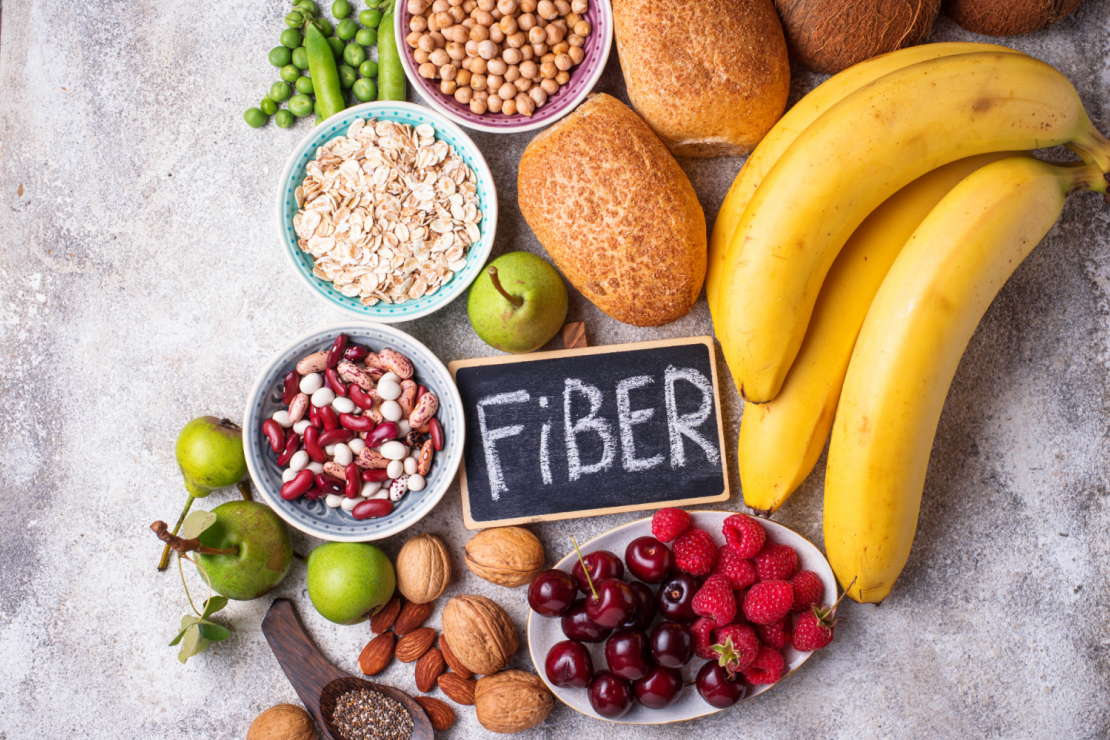Why is Fiber Important for Digestion, Absorption, and Weight Loss?
Discover why fiber is essential for digestion, nutrient absorption, and weight loss. Learn about the best high-fiber foods, daily requirements, and how fiber supports gut health and sustainable fat loss.

Table of Content
Introduction: Fiber – The Unsung Hero of Healthy Digestion and Weight Loss
In the world of nutrition, fiber often takes a backseat to more popular nutrients like protein and healthy fats. However, this unsung hero plays a crucial role in maintaining digestive health, supporting nutrient absorption, and facilitating sustainable weight loss. Understanding fiber's importance can transform your approach to healthy eating and weight management.
What Is Fiber and Why Is It Important?
Dietary fiber is a type of carbohydrate that the body cannot digest. Unlike other nutrients, fiber passes through your digestive system relatively intact, providing numerous health benefits along the way. This unique characteristic makes fiber an essential component of a healthy diet, playing crucial roles in everything from digestive health to weight management and disease prevention.
The importance of fiber extends far beyond basic nutrition. Research has shown that adequate fiber intake is associated with reduced risk of various health conditions, including heart disease, type 2 diabetes, and certain types of cancer. Fiber also plays a vital role in maintaining a healthy gut microbiome, which is increasingly recognized as a cornerstone of overall health.
- Disease Prevention: Regular fiber intake helps reduce the risk of heart disease, stroke, and colorectal cancer
- Blood Sugar Control: Fiber slows sugar absorption, helping maintain stable blood glucose levels
- Cholesterol Management: Soluble fiber helps lower LDL (bad) cholesterol levels
- Gut Health: Acts as a prebiotic, feeding beneficial gut bacteria
- Weight Management: Promotes feelings of fullness and helps control calorie intake
There are two main types of fiber, each with distinct properties and benefits:
| Type of Fiber | Characteristics | Common Sources | Benefits |
|---|---|---|---|
| Soluble Fiber | Dissolves in water, forms a gel-like substance | Oats, barley, fruits, legumes, nuts | Lowers cholesterol, regulates blood sugar, promotes satiety |
| Insoluble Fiber | Does not dissolve in water, adds bulk | Whole grains, vegetables, wheat bran | Promotes regular bowel movements, prevents constipation |
Fiber and Digestion: How It Works
Fiber's role in digestion is complex and multifaceted. As it moves through your digestive system, fiber performs various functions that support healthy digestion and optimal gut function. The process begins in your mouth, where fiber-rich foods require more chewing, triggering increased saliva production and digestive enzymes.
In the stomach and small intestine, soluble fiber forms a gel-like substance that slows down digestion, while insoluble fiber adds bulk to waste material. This combination helps maintain regular bowel movements and supports the growth of beneficial gut bacteria, creating a healthy digestive environment.
- Mechanical Action:
- Adds bulk and softness to stool
- Stimulates intestinal muscles
- Promotes regular bowel movements
- Bacterial Function:
- Feeds beneficial gut bacteria
- Produces short-chain fatty acids
- Maintains gut barrier integrity
- Water Balance:
- Attracts water to the intestines
- Softens stool consistency
- Prevents constipation
Fiber and Nutrient Absorption
While fiber itself isn't absorbed by the body, it plays a crucial role in how other nutrients are absorbed and utilized. The gel-forming properties of soluble fiber create a slow-release mechanism that optimizes nutrient absorption and maintains steady blood sugar levels. This process is particularly important for the absorption of minerals and water-soluble vitamins.
Furthermore, fiber's influence on gut bacteria leads to the production of short-chain fatty acids (SCFAs), which improve the gut's ability to absorb minerals like calcium and magnesium. The fermentation of fiber by gut bacteria also produces vitamins, particularly vitamin K and some B vitamins.
- Enhanced Nutrient Absorption:
- Slows digestion for optimal nutrient uptake
- Improves mineral absorption through SCFA production
- Supports vitamin synthesis by gut bacteria
- Blood Sugar Regulation:
- Slows glucose absorption
- Reduces insulin spikes
- Improves glycemic control
- Gut Health Benefits:
- Maintains healthy gut barrier function
- Reduces inflammation
- Supports beneficial bacteria growth
Fiber for Weight Loss: The Science
Scientific research has consistently shown that fiber is a powerful tool for weight management. The mechanisms behind fiber's weight loss benefits are multifaceted, involving both physical and metabolic effects. High-fiber foods typically require more chewing, which naturally slows down eating and allows your body's satiety signals to function properly.
Moreover, fiber's ability to absorb water and expand in the stomach creates a physical feeling of fullness, while its effects on gut hormones influence appetite and metabolism at a biochemical level. Studies have shown that individuals who consume more fiber typically consume fewer calories overall and maintain more stable blood sugar levels.
- Physical Effects:
- Creates bulk in the stomach
- Slows down eating process
- Requires more chewing
- Provides longer-lasting satiety
- Metabolic Impact:
- Regulates hunger hormones
- Stabilizes blood sugar levels
- Reduces insulin resistance
- Improves metabolic health
- Caloric Impact:
- Reduces overall calorie absorption
- Lowers energy density of meals
- Supports healthy gut bacteria
- Enhances fat oxidation
Best Fiber-Rich Foods for Digestion and Weight Loss
Incorporating fiber-rich foods into your diet is essential for optimal digestion and successful weight management. The best sources of dietary fiber offer a combination of both soluble and insoluble fiber, along with other beneficial nutrients that support overall health. When selecting high-fiber foods, it's important to choose a variety of sources to ensure you're getting different types of fiber and a broad spectrum of nutrients.
Many of these foods also offer additional health benefits beyond their fiber content, such as antioxidants, healthy fats, and protein, making them excellent choices for a balanced diet. Here's a comprehensive look at some of the best fiber-rich foods and their specific benefits:
| Food | Fiber per Serving | Serving Size | Additional Benefits |
|---|---|---|---|
| Chia Seeds | 10g | 2 tablespoons | Omega-3s, protein, calcium |
| Lentils | 15g | 1 cup (cooked) | Protein, iron, B vitamins |
| Avocado | 9g | 1 medium | Healthy fats, potassium, vitamin E |
| Raspberries | 8g | 1 cup | Antioxidants, vitamin C |
| Black Beans | 15g | 1 cup (cooked) | Protein, iron, magnesium |
| Artichokes | 10g | 1 medium | Antioxidants, vitamin C, K |
| Pears | 5.5g | 1 medium | Vitamin C, potassium |
| Quinoa | 5g | 1 cup (cooked) | Complete protein, minerals |
- Best Sources for Weight Loss:
- Low-calorie, high-fiber vegetables (broccoli, Brussels sprouts)
- Fiber-rich fruits with low glycemic index
- Legumes with high protein content
- Whole grains that provide sustained energy
- Optimal Combinations:
- Pair high-fiber foods with protein for satiety
- Combine soluble and insoluble fiber sources
- Include both raw and cooked fiber-rich foods
- Balance with healthy fats for nutrient absorption
How Much Fiber Do You Need Daily?
Daily fiber recommendations vary by age and gender:
| Age Group | Women | Men |
|---|---|---|
| 19-50 years | 25g | 38g |
| 51+ years | 21g | 30g |
Tips to Add More Fiber to Your Diet
Incorporating more fiber into your diet doesn't have to be complicated. Here are practical tips:
- Start your day with high-fiber breakfast cereals or oatmeal
- Replace white bread and pasta with whole grain versions
- Add beans or lentils to soups and salads
- Snack on fruits, vegetables, and nuts
- Include a variety of colorful vegetables with every meal
- Sprinkle seeds (chia, flax, hemp) on yogurt or smoothies
FAQs About Fiber
What does fiber do in your digestive system?
Fiber aids digestion by adding bulk to stool, feeding beneficial gut bacteria, and helping maintain regular bowel movements. It also slows down digestion for better nutrient absorption and helps prevent digestive issues like constipation.
Why is fiber good for losing weight?
Fiber supports weight loss by increasing satiety, reducing calorie intake, improving gut health, and stabilizing blood sugar levels. High-fiber foods are typically lower in calories and take longer to eat, helping you feel full with fewer calories.
How much fiber should I eat per day for weight loss?
For weight loss, aim to meet or slightly exceed the daily recommended intake (25g for women, 38g for men). Gradually increase your fiber intake and drink plenty of water to avoid digestive discomfort.
What foods are highest in fiber for gut health?
The best high-fiber foods for gut health include:
- Legumes (beans, lentils, peas)
- Whole grains (oats, quinoa, brown rice)
- Berries (raspberries, blackberries)
- Leafy greens (spinach, kale)
- Seeds (chia, flax, pumpkin)
- Nuts (almonds, pistachios)
Start Your Health Journey Today
Download Macro Tracking AI and take control of your nutrition with the power of artificial intelligence.
Download on App Store

